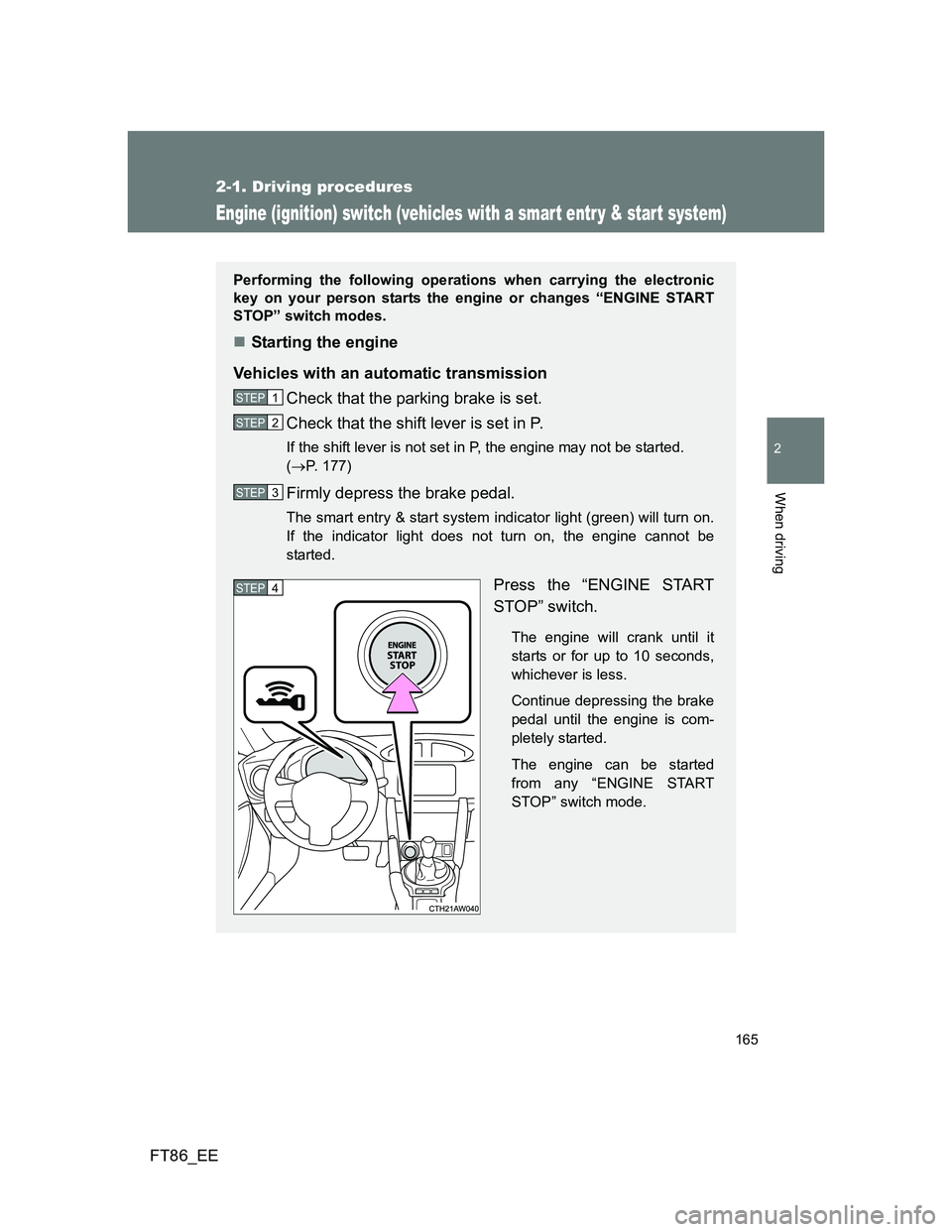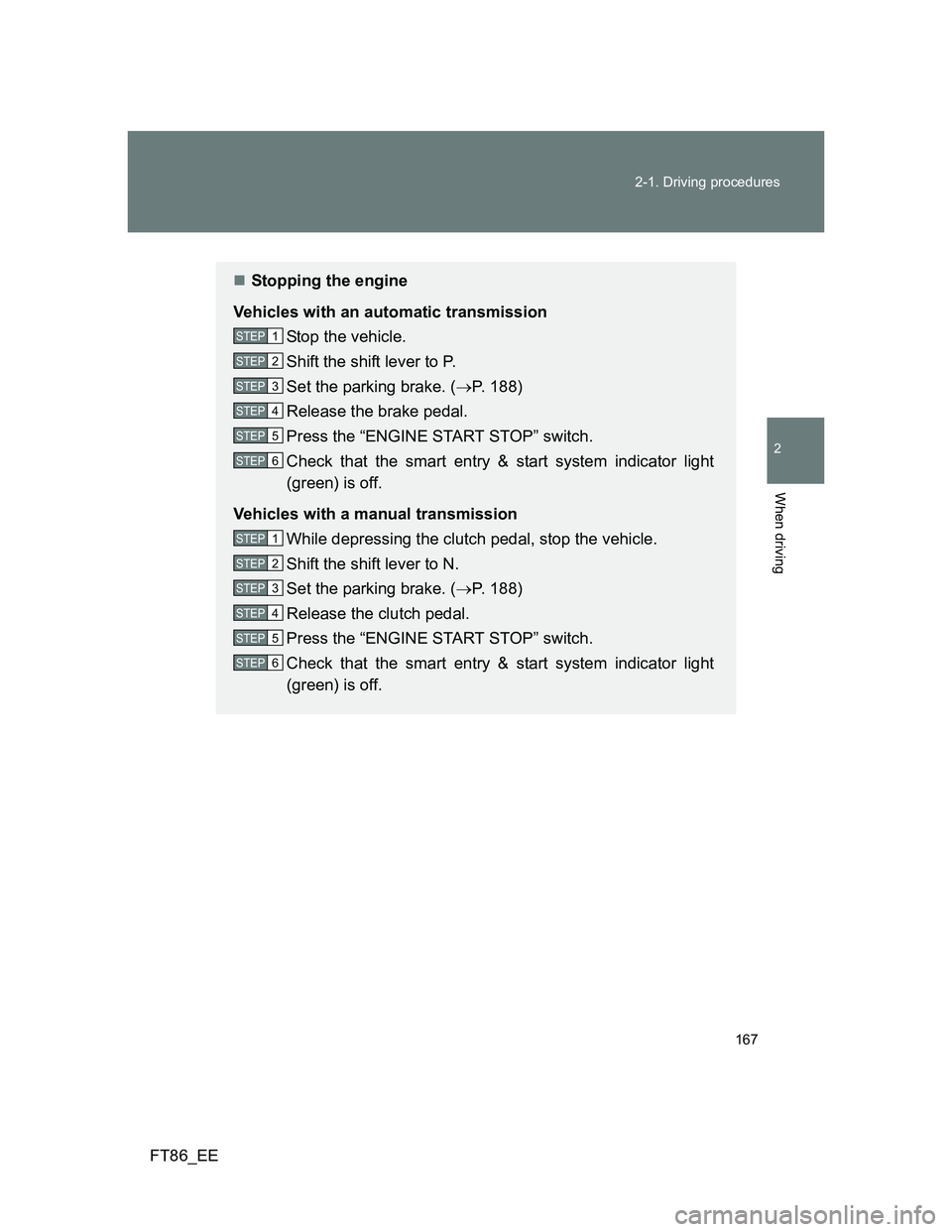2012 TOYOTA GT86 check engine light
[x] Cancel search: check engine lightPage 4 of 448

TABLE OF CONTENTSIndex
FT86_EE
4
4-1. Maintenance and care
Cleaning and protecting
the vehicle exterior ........... 278
Cleaning and protecting
the vehicle interior ............ 282
Cleaning and protecting
the Alcantara
® area .......... 286
4-2. Maintenance
Maintenance
requirements..................... 288
4-3. Do-it-yourself maintenance
Do-it-yourself service
precautions ....................... 291
Hood ................................... 294
Positioning a floor jack ........ 296
Engine compartment........... 298
Tires .................................... 311
Tire inflation pressure ......... 314
Wheels ................................ 316
Air conditioning filter ........... 318
Wireless remote control/
electronic key battery........ 320
Checking and replacing
fuses ................................. 324
Light bulbs .......................... 3325-1. Essential information
Emergency flashers ........... 352
If your vehicle needs to be
towed ............................... 353
If you think something is
wrong ............................... 360
Fuel pump shut off
system.............................. 361
5-2. Steps to take in an
emergency
If a warning light turns
on or a warning buzzer
sounds... ......................... 362
If you have a flat tire
(vehicles with a spare
tire) ................................... 371
If you have a flat tire
(vehicles with an
emergency tire puncture
repair kit) .......................... 379
If the engine will not start ... 394
If the shift lever cannot
be shifted from P .............. 397
If you lose your keys .......... 398
If the electronic key does
not operate properly ......... 399
If the battery is
discharged ....................... 403
If your vehicle overheats .... 408
If the vehicle becomes
stuck................................. 411
4Maintenance and care5When trouble arises
Page 80 of 448

80 1-4. Opening and closing the windows
FT86_EE
When the power window does not close normally
If the jam protection function is operating abnormally and a window cannot
be closed, close all the doors and perform the following operations using the
power window switch on the relevant door.
Vehicles without a smart entry & start system: After stopping the
vehicle, the engine switch is turned to the “ON” position.
Vehicles with a smart entry & start system: After stopping the vehi-
cle, the “ENGINE START STOP” switch is turned to IGNITION ON
mode.
Hold the power window switch in the one-touch closing position two
consecutive times.
Hold the power window switch in the one-touch closing position
once again and continue holding for 1 second or more after the win-
dow closes completely.
If you push the power window switch to the opening position while the win-
dow is moving, start again from the beginning. If the window continues to
close but then re-open slightly even after performing the above procedure
correctly, have the vehicle inspected by any authorized Toyota dealer or
repairer, or another duly qualified and equipped professional.
CAUTION
Closing the windows
Observe the following precautions.
Failure to do so may result in death or serious injury.
Check to make sure that all passengers do not have any part of their body
in a position where it could be caught when a window is being operated.
Do not allow children to operate the power windows.
Closing a power window on someone can cause serious injury, and in
some instances, even death.
Jam protection function
Never use any part of your body to intentionally activate the jam protection
function.
The jam protection function may not work if something gets caught just
before the window fully closes.
STEP 1
STEP 2
STEP 3
Page 124 of 448

124 1-7. Safety information
FT86_EE
CAUTION
SRS warning light
If the warning light exhibits any of the following conditions, there may be a
malfunction in the seat belt pretensioners and/or SRS airbag system. We
recommend that you have the system checked immediately by your nearest
any authorized Toyota dealer or repairer, or another duly qualified and
equipped professional. Unless checked and properly repaired, the seat belt
pretensioners and/or SRS airbags will operate improperly (e.g. SRS airbags
may inflate in a very minor collision or not inflate in a severe collision), which
may increase the risk of injury.
Flashing or flickering of the warning light
No illumination of the warning light when the engine switch is first turned to
the “ON” position (vehicles without a smart entry & start system), or the
“ENGINE START STOP” switch is turned to “ON” mode (vehicles with a
smart entry & start system).
Continuous illumination of the warning light
Illumination of the warning light while driving
Page 158 of 448

158 2-1. Driving procedures
FT86_EE
CAUTION
Use engine braking (downshift) to maintain a safe speed when driving
down a steep hill.
Using the brakes continuously may cause the brakes to overheat and lose
effectiveness. (P. 178, 184)
Do not adjust the position of the steering wheel, the seat, or the inside or
outside rear view mirrors while driving.
Doing so may result in a loss of vehicle control that can cause accidents,
resulting in death or serious injury.
Always check that all passengers' arms, heads or other parts of their body
are not outside the vehicle, as this may result in death or serious injury.
When driving on slippery road surfaces
Sudden braking, acceleration and steering may cause tire slippage and
reduce your ability to control the vehicle, resulting in an accident.
Sudden acceleration, engine braking due to shift changing, or changes in
engine speed could cause the vehicle to skid, resulting in an accident.
After driving through a puddle, lightly depress the brake pedal to make
sure that the brakes are functioning properly. Wet brake pads may prevent
the brakes from functioning properly. If the brakes on only one side are wet
and not functioning properly, steering control may be affected, resulting in
an accident.
When shifting the shift lever
On vehicles with an automatic transmission, be careful not to shift the shift
lever with the accelerator pedal depressed. Shifting the shift lever to a
gear other than P or N may lead to unexpected rapid acceleration of the
vehicle that may cause an accident and result in death or serious injury.
Do not place items in the shift lever's surrounding area. It may cause incor-
rect operation.
If the shift boot is pulled out during cleaning, return it to its previous posi-
tion. If the shift boot is left pulled out, the shift lever may become difficult to
operate.
Page 165 of 448

165
2-1. Driving procedures
2
When driving
FT86_EE
Engine (ignition) switch (vehicles with a smar t entr y & star t system)
Performing the following operations when carrying the electronic
key on your person starts the engine or changes “ENGINE START
STOP” switch modes.
Starting the engine
Vehicles with an automatic transmission
Check that the parking brake is set.
Check that the shift lever is set in P.
If the shift lever is not set in P, the engine may not be started.
(P. 177)
Firmly depress the brake pedal.
The smart entry & start system indicator light (green) will turn on.
If the indicator light does not turn on, the engine cannot be
started.
Press the “ENGINE START
STOP” switch.
The engine will crank until it
starts or for up to 10 seconds,
whichever is less.
Continue depressing the brake
pedal until the engine is com-
pletely started.
The engine can be started
from any “ENGINE START
STOP” switch mode.
STEP 1
STEP 2
STEP 3
STEP 4
Page 166 of 448

166 2-1. Driving procedures
FT86_EE
Vehicles with a manual transmission
Check that the parking brake is set.
Check that the shift lever is set in N.
Firmly depress the clutch pedal.
The smart entry & start system indicator light (green) will turn on.
If the indicator light does not turn on, the engine cannot be
started.
Press the “ENGINE START
STOP” switch.
The engine will crank until it
starts or for up to 10 seconds,
whichever is less.
Continue depressing the clutch
pedal until the engine is com-
pletely started.
The engine can be started
from any “ENGINE START
STOP” switch mode.
STEP 1
STEP 2
STEP 3
STEP 4
Page 167 of 448

167 2-1. Driving procedures
2
When driving
FT86_EE
Stopping the engine
Vehicles with an automatic transmission
Stop the vehicle.
Shift the shift lever to P.
Set the parking brake. (P. 188)
Release the brake pedal.
Press the “ENGINE START STOP” switch.
Check that the smart entry & start system indicator light
(green) is off.
Vehicles with a manual transmission
While depressing the clutch pedal, stop the vehicle.
Shift the shift lever to N.
Set the parking brake. (P. 188)
Release the clutch pedal.
Press the “ENGINE START STOP” switch.
Check that the smart entry & start system indicator light
(green) is off.
STEP 1
STEP 2
STEP 3
STEP 4
STEP 5
STEP 6
STEP 1
STEP 2
STEP 3
STEP 4
STEP 5
STEP 6
Page 169 of 448

169 2-1. Driving procedures
2
When driving
FT86_EE
When stopping the engine with the shift lever in a position other
than P (vehicles with an automatic transmission)
If the engine is stopped with the shift lever in a position other than P,
the “ENGINE START STOP” switch will not be turned off but instead
be turned to ACCESSORY mode. Perform the following procedure to
turn the switch off:
Check that the parking brake is set.
Shift the shift lever to P.
Check that the smart entry & start system indicator light
(green) flashes slowly and then press the “ENGINE START
STOP” switch once.
Check that the smart entry & start system indicator light
(green) is off.
Auto power off function
Vehicles with an automatic transmission
If the vehicle is left in ACCESSORY or IGNITION ON mode (the engine is
not running) for more than an hour with the shift lever in P, the “ENGINE
START STOP” switch will automatically turn off. However, this function can-
not entirely prevent battery discharge. Do not leave the vehicle with the
“ENGINE START STOP” switch in ACCESSORY or IGNITION ON mode for
long periods of time when the engine is not running.
Vehicles with a manual transmission
If the vehicle is left in ACCESSORY or IGNITION ON mode (the engine is
not running) for more than an hour, the “ENGINE START STOP” switch will
automatically turn off. However, this function cannot entirely prevent battery
discharge. Do not leave the vehicle with the “ENGINE START STOP” switch
in ACCESSORY or IGNITION ON mode for long periods of time when the
engine is not running.
STEP 1
STEP 2
STEP 3
STEP 4